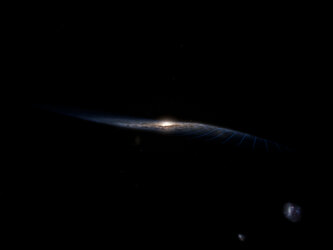

Science & Exploration
Milky Way's precessing galactic disc
Data from ESA’s star-observing satellite Gaia shows that the warped galactic disc of the Milky Way precesses, or wobbles, similarly to the motion of a spinning top. The warp moves around the centre of the Milky Way faster than previously expected, completing one rotation in 600 to 700 million years. That’s however, still slower than the speed at which the stars in the disc orbit the galactic centre. Our mother star, the Sun (shown in the animation as the small yellow dot), for example, requires only 220 million years to complete one orbit.
The speed of the warp’s precession led astronomers to believe that it must be caused by something rather powerful, such an ongoing collision with a smaller galaxy.





